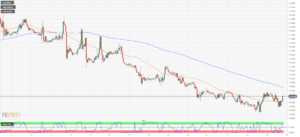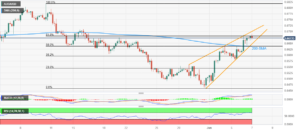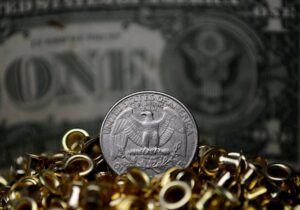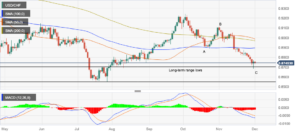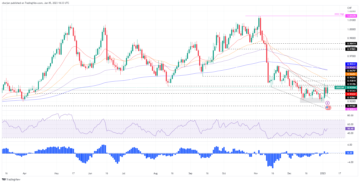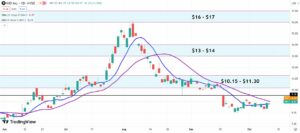
- Gold price falls back as the “early rate-cuts” narrative wanes.
- The Fed needs more evidence to be confident that inflation will return to 2%.
- The US Dollar advances ahead of ISM Manufacturing PMI, NFP data.
Gold price (XAU/USD) faces an intense sell-off in Thursday’s early New York session. The upside in the Gold price remained restricted as the Federal Reserve (Fed) has pushed back expectations of a rate cut in March. Fed Chair Jerome Powell showed disinterest in rate-cut speculation, arguing that policymakers are still unconvinced that underlying inflation will sustainably return to the 2% target. As Jerome Powell has spooked expectations of rate cuts in March, investors have turned to May’s policy meeting for the first rate cut of this cycle.
As we advance, the inflation outlook will be guided by labor market conditions, consumer spending, and economic growth, which will set a fresh undertone for rate-cut expectations.
Meanwhile, investors await January's Institute for Supply Management's (ISM) Manufacturing PMI and the Nonfarm Payrolls (NFP) data. The expectations of a rate cut at May’s Fed monetary policy meeting could wane if the employment and wage growth data turn out higher than expected.
Daily digest market movers: Gold price drops vertically while US Dollar holds strength
- Gold price falls sharply from the day’s high near $2,050 as investors shift back to the narrative that the Federal Reserve is not interested in reducing interest rates in March.
- In his monetary policy statement on Wednesday, Fed Chair Jerome Powell turned down speculation for reducing interest rates until policymakers get greater confidence that underlying inflation will sustainably return to the 2% target.
- A strict denial for rate cuts in March has shifted expectations to the May policy meeting.
- As per the CME Fedwatch tool, traders see a 61% chance of a rate cut by 25 basis points (bps) to 5.00%-5.25% for May.
- The Fed’s decision to keep interest rates unchanged in the range of 5.25%-5.50% for the fourth straight time was widely anticipated.
- Also, Jerome Powell said, “risks to achieving full employment and 2% inflation are better balanced.”
- The US Dollar Index (DXY) rises to near 103.80 as expectations for rate cuts shift to May. Until then, various economic data are lined up that will guide further action in the safe-haven assets.
- In today’s session, market participants will focus on the ISM Manufacturing PMI for January and the Initial Jobless Claims (IJC) for the week ending January 26.
- According to the estimates, the Manufacturing PMI fell to 47.0 from December’s reading of 47.4. The reasoning behind lower factory output would be higher furloughs due to the festive mood.
- The Manufacturing PMI data will be followed by the official Employment data for January, which will be published on Friday.
- The private Employment Change data, reported by the ADP on Wednesday, showed that private employers recruited 107K workers in December, which was significantly lower than expectations of 145K and the former reading of 158K.
- This has set a negative undertone for the NFP data ahead. Investors anticipate that overall payroll additions slowed to 180K against 216K in December. The Unemployment Rate is expected to increase to 3.8% from 3.7%.
- Apart from employment numbers, wage growth data will in be the focus as it will guide inflation, being a major contributor to high price pressures.
- The annual Average Hourly Earnings is seen steady at 4.1%. The month-on-month wage growth may have grown at a slower pace of 0.3% against a 0.4% increase in December. A slowdown in the wage growth data would soften the inflation outlook.
Technical Analysis: Gold price seems vulnerable below $2,030
Gold price falls vertically ahead of the US ISM Manufacturing PMI and the Employment data. From a technical perspective, the broader outlook for the precious metal is upbeat as it has delivered a breakout of the Symmetrical Triangle chart pattern formed on a daily timeframe. The 20-day Exponential Moving Average (EMA) at $2,032.50 is acting as a cushion for the Gold price.
The 14-period Relative Strength Index (RSI) is approaching the 60.00 hurdle. If the RSI manages to sustain above the hurdle, bullish momentum could be triggered.
Fed FAQs
Monetary policy in the US is shaped by the Federal Reserve (Fed). The Fed has two mandates: to achieve price stability and foster full employment. Its primary tool to achieve these goals is by adjusting interest rates.
When prices are rising too quickly and inflation is above the Fed’s 2% target, it raises interest rates, increasing borrowing costs throughout the economy. This results in a stronger US Dollar (USD) as it makes the US a more attractive place for international investors to park their money.
When inflation falls below 2% or the Unemployment Rate is too high, the Fed may lower interest rates to encourage borrowing, which weighs on the Greenback.
The Federal Reserve (Fed) holds eight policy meetings a year, where the Federal Open Market Committee (FOMC) assesses economic conditions and makes monetary policy decisions.
The FOMC is attended by twelve Fed officials – the seven members of the Board of Governors, the president of the Federal Reserve Bank of New York, and four of the remaining eleven regional Reserve Bank presidents, who serve one-year terms on a rotating basis.
In extreme situations, the Federal Reserve may resort to a policy named Quantitative Easing (QE). QE is the process by which the Fed substantially increases the flow of credit in a stuck financial system.
It is a non-standard policy measure used during crises or when inflation is extremely low. It was the Fed’s weapon of choice during the Great Financial Crisis in 2008. It involves the Fed printing more Dollars and using them to buy high grade bonds from financial institutions. QE usually weakens the US Dollar.
Quantitative tightening (QT) is the reverse process of QE, whereby the Federal Reserve stops buying bonds from financial institutions and does not reinvest the principal from the bonds it holds maturing, to purchase new bonds. It is usually positive for the value of the US Dollar.
- SEO Powered Content & PR Distribution. Get Amplified Today.
- PlatoData.Network Vertical Generative Ai. Empower Yourself. Access Here.
- PlatoAiStream. Web3 Intelligence. Knowledge Amplified. Access Here.
- PlatoESG. Carbon, CleanTech, Energy, Environment, Solar, Waste Management. Access Here.
- PlatoHealth. Biotech and Clinical Trials Intelligence. Access Here.
- Source: https://www.fxstreet.com/news/gold-price-fails-to-hold-gains-as-fed-pushes-against-rate-cut-hopes-in-march-202402011034
- :has
- :is
- :not
- :where
- $UP
- 2%
- 2% Inflation
- 2008
- 25
- 26
- 31
- 40
- 50
- 60
- 80
- a
- above
- Achieve
- achieving
- acting
- Action
- additions
- adjusting
- adp
- advance
- advances
- against
- ahead
- an
- analysis
- and
- Animate
- annual
- anticipate
- Anticipated
- approaching
- ARE
- AS
- assesses
- Assets
- At
- attractive
- average
- await
- back
- Balanced
- Bank
- basis
- BE
- behind
- being
- below
- Better
- board
- Bonds
- Borrowing
- breakout
- broader
- Bullish
- buy
- Buying
- by
- Chair
- Chance
- change
- choice
- claims
- CME
- committee
- conditions
- confidence
- confident
- consumer
- content
- contributor
- Costs
- could
- credit
- crises
- crisis
- Cut
- cuts
- cycle
- daily
- data
- December
- decision
- decisions
- delivered
- Digest
- does
- Dollar
- dollar index
- dollars
- down
- Drops
- due
- during
- Dxy
- Early
- Earnings
- easing
- Economic
- Economic Conditions
- Economic growth
- economy
- eight
- eleven
- EMA
- employers
- employment
- encourage
- ending
- ends
- estimates
- evidence
- expanded
- expectations
- expected
- exponential
- exponential moving average
- extreme
- extremely
- faces
- factory
- Falls
- FAQ
- Fed
- Fed Chair
- Fed Chair Jerome Powell
- Federal
- Federal Open Market Committee
- federal reserve
- Federal Reserve Bank
- Federal Reserve Bank of New York
- financial
- financial crisis
- Financial institutions
- financial system
- First
- flow
- Focus
- followed
- FOMC
- For
- formed
- Former
- Foster
- four
- Fourth
- fresh
- Friday
- from
- full
- further
- get
- Goals
- Gold
- gold price
- governors
- grade
- great
- greater
- Greenback
- grown
- Growth
- guide
- guided
- Have
- High
- higher
- his
- holds
- HTTPS
- hurdle
- if
- in
- Increase
- Increases
- increasing
- index
- inflation
- initial
- Institute
- institutions
- intense
- interest
- Interest Rates
- interested
- International
- international investors
- Investors
- involves
- IT
- ITS
- January
- jerome
- jerome powell
- jobless claims
- jpg
- Keep
- labor
- labor market
- lined
- Low
- lower
- major
- MAKES
- management
- manages
- mandates
- manufacturing
- March
- Market
- market conditions
- May..
- measure
- meeting
- meetings
- Members
- metal
- module
- Momentum
- Monetary
- Monetary Policy
- money
- mood
- more
- Movers
- moving
- moving average
- Named
- NARRATIVE
- Near
- needs
- negative
- New
- New York
- nfp
- numbers
- of
- official
- officials
- on
- open
- or
- out
- Outlook
- output
- overall
- Pace
- Park
- participants
- Pattern
- Payroll
- per
- perspective
- Place
- plato
- Plato Data Intelligence
- PlatoData
- pmi
- points
- policy
- policymakers
- positive
- Powell
- Precious
- president
- Presidents
- price
- Prices
- primary
- Principal
- printing
- private
- process
- published
- purchase
- pushed
- QE
- QT
- quantitative
- Quantitative Easing
- quickly
- raises
- range
- Rate
- Rates
- Reading
- reducing
- regional
- reinvest
- relative
- relative strength index
- Relative Strength Index (RSI)
- remaining
- Reported
- Reserve
- reserve bank
- Resort
- restricted
- Results
- return
- reverse
- Rises
- rising
- rsi
- s
- Said
- see
- seems
- seen
- serve
- session
- set
- seven
- shaped
- shift
- shifted
- showed
- significantly
- situations
- Slowdown
- speculation
- Spending
- Stability
- starts
- Statement
- steady
- Still
- Stops
- straight
- strength
- strict
- stronger
- substantially
- supply
- sustainably
- Symmetrical Triangle
- system
- Target
- Technical
- terms
- than
- that
- The
- the Fed
- their
- Them
- then
- These
- this
- throughout
- tightening
- time
- timeframe
- to
- today’s
- too
- tool
- Traders
- triggered
- TURN
- Turned
- two
- underlying
- unemployment
- unemployment rate
- until
- upbeat
- us
- US Dollar
- US Dollar Index
- US ISM Manufacturing
- US ISM Manufacturing PMI
- USD
- used
- using
- usually
- value
- various
- vertically
- wage
- was
- we
- Wednesday
- week
- weighs
- when
- which
- while
- WHO
- widely
- will
- workers
- would
- XAU/USD
- year
- york
- zephyrnet

